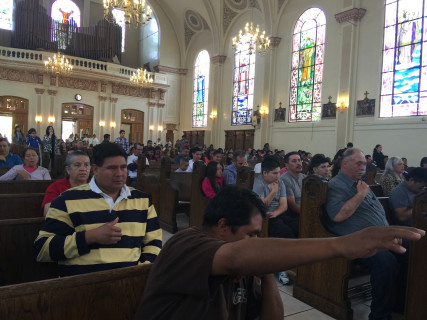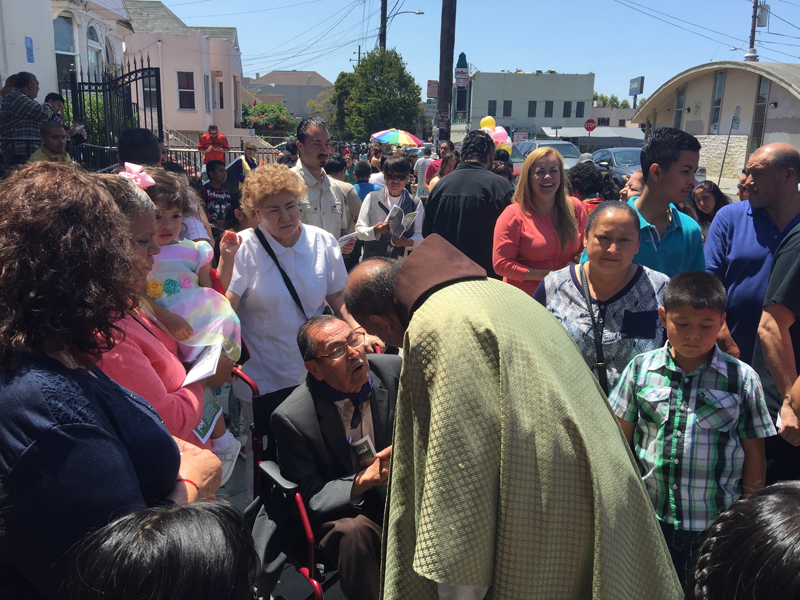
Saint Elizabeth Catholic Church in Oakland, Calif., has 15 Spanish-language Masses each week. Religion News Service photo by Kimberly Winston
OAKLAND, Calif. (RNS) The 37 double rows of wooden pews are so packed for Sunday Mass that worshippers at St. Elizabeth Catholic Church must stand one and two deep around the walls of the sanctuary.
More stand in the back and some are even on the steps outside, listening through the open front doors. And it is a young crowd — few have gray hair, and so many have small children in arms that the 85-minute service is constantly punctuated with the wails of babies.
No special holy day has brought out the crowds. It is just an average summer Sunday, a period the church calls “ordinary time.”
“Bienvenidos a Santa Elizabeth,” the Rev. Oscar Mendez says from the altar of this stucco church in the heart of Oakland’s Fruitvale district, where the majority of residents are, like him, from south of the U.S. – Mexican border. “Estamos felices de veres.”
“Welcome to St. Elizabeth. We are happy to see you.”

The Rev. Oscar Mendez is surrounded by Latino worshippers at Oakland’s St. Elizabeth parish. Religion News Service photo by Kimberly Winston
Mendez speaks Spanish through the entire Mass, one of 15 offered in that language each week here. Established by German immigrants in 1892, St. Elizabeth parish is now one of the largest and most vibrant Hispanic parishes in the San Francisco Bay Area — up to 6,000 Latinos attend Mass each weekend, the local diocese reports.
It is also emblematic of an ongoing shift among America’s 68.1 million parish-connected Catholics. The number of Latino Catholics in the U.S. has grown to 34 percent of the total, up from 29 percent in 2007, according to the Pew Research Center. And the bulk of Latino Catholics — 77 percent — live in the West or the South.
Meanwhile, in New York, Boston and other Eastern Seaboard cities, empty parishes, schools and hospitals are being closed or consolidated, while the church is seeing rapid growth in Western and Southern states such as Arizona, Texas and Georgia. The Archdiocese of Los Angeles is the largest in the U.S., with more than 4 million Catholics — twice the number in the Archdiocese of New York, where the number of parishes has fallen by 20 percent since 2014.
Yet when Pope Francis makes his first visit to the United States next week (Sept. 22-27), he will stop only in Philadelphia, New York City and Washington, D.C. What, if anything, will he miss about the character of the U.S. Catholic Church that he can’t experience from the City of Brotherly Love, his westernmost stop?
“I would have loved to see the pope fly in for one day to Los Angeles,” said Hosffman Ospino, an assistant professor of Hispanic ministry at Boston College. “Just come to make a statement that that is where the church is growing and if you want to see the face of the Catholic Church in the 21st century you have to go to the Southwest, you have to go to a place like LA.”
So what differences would Pope Francis see in the Western U.S.?
Ospino characterized the church in the East as more outwardly focused. Most U.S. Catholic institutions are based there — colleges, universities and health care organizations, as well as official church bodies such as the U.S. Conference of Catholic Bishops. It is more concerned with public policy and politics than the church in the South and the West, which is more inwardly turned, he said.
“If you want to affect the church’s political agenda, you won’t go to Houston, you will go to Washington, D.C.” Ospino said. “So while there is a strong Catholic presence in the West, it is not right now a presence that is defining the Catholic agenda in this country.”
Outside the East Coast, where Catholicism has had a stronghold since the influx of Irish, German, Polish and Italian immigrants in the middle of the 19th century, the church must also be “more evangelical,” said Notre Dame professor Timothy Matovina, author of “Latino Catholicism: Transformation in America’s Largest Church.”
“In the Bible Belt, the Catholic Church does things with more vigor because they realize the Protestant church up the street is competing for its people,” Matovina said. “Traditionally, in the East, you didn’t have to work as hard — people were born Catholic and they stayed Catholic.”
Another difference will be in age. West Coast Latino parishioners are much younger than the average U.S. Catholic — another factor in the Western church’s steady growth. The median age of American Catholics is 53; the median age of Hispanic Catholics is 42, according to Pew.
“If I do a 5 o’clock Mass in English, I could be the youngest person in the room,” Bishop Joseph Tyson, 57, told America magazine of his Yakima, Wash., diocese, where the average age of worshippers was 23 earlier this year. “But if I do a Mass in Spanish, I assure you I could be the oldest. We have lots of young folks.”
And that age difference is likely to bring change. The church’s power brokers may be in the East now, but church growth out West could budge them.
“My sense is that as we move into the future we are going to see more of the Catholic Church investing in Latinos and Asians,” another young and growing Catholic community, said Boston College’s Ospino. “If the Catholic Church starts investing in these new voices in the South and West, these people are going to start building new schools and hospitals and my sense is the center of power will change, the center of Catholic influence will change.
“Why should most of the decisions about Catholic life be made in Boston or Philadelphia or D.C. when they can be made in Houston or Los Angeles or Phoenix?” Ospino concluded. “It just seems natural to me.”
LM/MG END WINSTON





